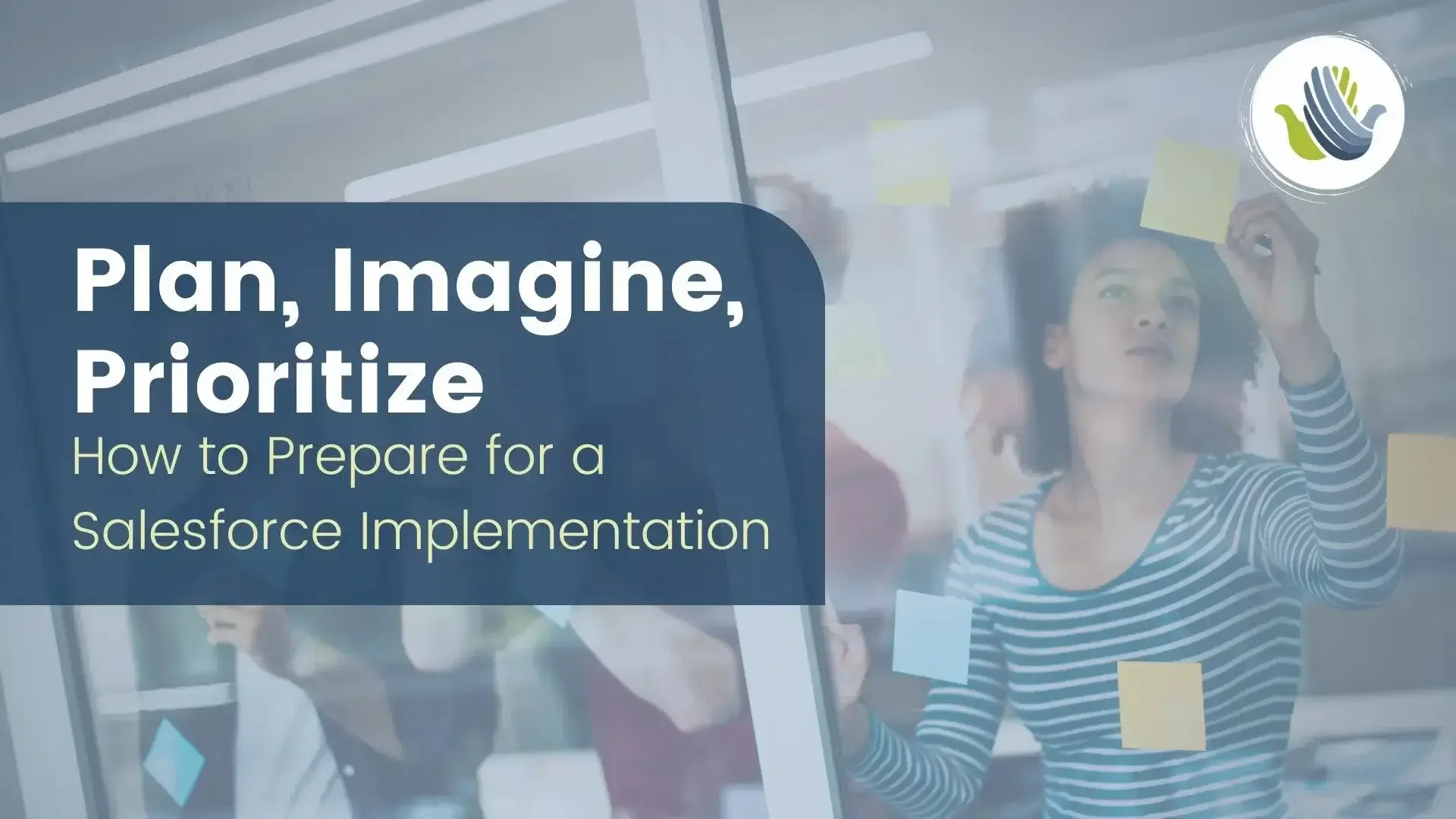Salesforce Implementation Guide & Checklist: Plan, Imagine, Prioritize
Implementing Salesforce is a major milestone for any organization. Whether you’re moving away from disconnected systems, replacing manual spreadsheets, or preparing to scale your operations, Salesforce offers the flexibility and power to transform the way your team works.
But here’s the truth: a Salesforce implementation is not just a technology upgrade. It’s an organizational change that requires planning, imagination, prioritization, and thoughtful execution. Without preparation, it’s easy to get overwhelmed by the possibilities—or to fall into the trap of implementing features that don’t align with your long-term goals.
That’s where this Salesforce implementation guide comes in. Below, we’ll walk through a structured approach to ensure your project starts strong. You’ll find a Salesforce implementation checklist that covers the essentials—from building a vision to identifying system champions to planning for future growth. And if you want a trusted partner to help you navigate the process with confidence, Provisio is here to guide you every step of the way.
Why Preparation Matters
Many organizations in the nonprofit, public sector, and philanthropy choose Salesforce after experiencing the frustrations of outdated or siloed systems. The promise of a single, powerful platform is exciting—but without preparation, you risk replicating old inefficiencies in new software.
A successful Salesforce implementation requires both technical setup and organizational alignment. You need to:
Define your goals clearly.
Engage your stakeholders early.
Prioritize your must-haves.
Train your people to embrace the change.
Think of your implementation as a journey. The better you prepare, the smoother that journey will be.
Step 1: Plan and Imagine Your Future State
The first step in this Salesforce implementation guide is to envision what success looks like. If your current processes have been in place for years, it can be difficult to imagine new ways of working. That’s why it’s important to start by gathering insights from the people who know your challenges best—your front-line staff.
Ask questions like:
Which processes take the most time?
Where are mistakes most likely to occur?
What would make your work easier if technology weren’t a barrier?
One client-facing leader at Provisio put it this way:
“Even if Salesforce is not 100% reading your mind, it’s better than that waste of time.”
Create a wish list of everything you’d like Salesforce to accomplish. Don’t censor your ideas at this stage—put all possibilities on the table. Later, you’ll prioritize based on impact, cost, and feasibility.
Step 2: Prioritize Your Wish List
Once you’ve brainstormed your ideal future state, the next step in your Salesforce implementation checklist is to prioritize requirements. Group them into three categories:
Must-haves – Features essential for your team’s daily work.
Nice-to-haves – Helpful enhancements that add value but aren’t urgent.
Future enhancements – Ideas that may be achievable in later phases.
For example, automating time-consuming tasks or introducing reminders that prevent missed follow-ups may belong in the must-have category, while advanced reporting dashboards may fall under nice-to-haves.
Prioritization helps you stay focused and ensures that your first implementation phase delivers quick wins. When your team sees immediate benefits, adoption increases—and so does enthusiasm for future phases.
Step 3: Identify System Champions
Every successful Salesforce implementation needs system champions—people inside your organization who advocate for the system, inspire excitement, and ease anxieties.
System champions are often:
Leaders who can communicate the long-term vision.
Trusted peers who encourage others to embrace change.
Early adopters who help with training and feedback.
At Provisio, we’ve seen how these champions reduce resistance and foster collaboration. As one of our business analysts jokes with clients:
“Remember: The new system is more scared of you than you are of it.”
By highlighting champions, you build momentum across your organization and make the transition smoother for everyone.
Step 4: Leverage Free Tools and Resources
Another key item in your Salesforce implementation checklist is to take advantage of free learning resources before and during your rollout. Salesforce’s official platform, Trailhead, is a fantastic place to start.
Trailhead offers:
Self-paced learning modules.
Best practices for Salesforce implementations.
Communities where you can connect with other users.
Encouraging your team to spend time in Trailhead can demystify Salesforce, build confidence, and make training more engaging. Instead of “homework,” think of it as an investment in user adoption and system success.
Step 5: Prepare Your Team for Change
A Salesforce implementation isn’t just a technology shift—it’s a cultural one. Your team members may worry about new processes or feel nervous about learning new software. Address these concerns proactively:
Communicate early and often about why the change is happening.
Provide clear training opportunities with support for different learning styles.
Celebrate small wins to reinforce progress.
When your staff understands how Salesforce will make their jobs easier, adoption skyrockets. A sense of urgency and excitement helps keep the momentum going throughout the implementation process.
Step 6: Plan for the Future
One of Salesforce’s greatest strengths is scalability. Your initial implementation should solve today’s problems—but don’t stop there.
Ask yourself:
How can Salesforce help us serve new clients or communities?
What other Salesforce tools (like Marketing Cloud, Service Cloud, or Nonprofit Cloud) might be useful in the future?
How will our system need to evolve as we grow?
By planning for the future now, you’ll set up a roadmap for continuous improvement. This ensures your investment keeps paying dividends long after the initial rollout.
Salesforce Implementation Checklist
Here’s a condensed version of the key steps covered in this Salesforce implementation guide:
Plan and Imagine – Define your ideal future state and gather team input.
Prioritize – Separate must-haves from nice-to-haves and future enhancements.
Identify System Champions – Appoint advocates who inspire and support your team.
Leverage Tools – Use Trailhead and other resources to build knowledge.
Prepare Your Team – Communicate, train, and celebrate progress.
Plan for the Future – Consider scalability and long-term goals.
Treat this Salesforce implementation checklist as a living document. Revisit it often to ensure you’re staying aligned with your goals and maximizing the value of Salesforce.
How Provisio Can Help
Preparing for a Salesforce implementation can feel overwhelming, but you don’t have to do it alone. At Provisio, we’ve helped organizations across the health and human services sector—and beyond—navigate this journey with confidence.
Our team brings:
Deep Salesforce expertise with many successful implementations.
Industry-specific knowledge that helps us anticipate your unique challenges.
A proven methodology for aligning technology with organizational goals.
We’ll partner with you from planning to ongoing support, ensuring that your Salesforce system delivers measurable results.
Ready to Get Started?
Your Salesforce journey begins with preparation—and now you have the framework to succeed. Use this Salesforce implementation guide and checklist as your roadmap, and let Provisio be your partner along the way.
Contact us today to start planning your Salesforce implementation with confidence.
FAQs
-
The timeline varies depending on your organization’s size, complexity, and requirements. On average, implementations can take anywhere from a few weeks for smaller projects to several months for enterprise-level rollouts.
-
Key participants include leadership, IT staff, front-line users, and designated system champions. Engaging a cross-functional team ensures that diverse needs are addressed and that adoption is successful.
-
While some organizations handle implementation internally, working with an experienced partner like Provisio provides expertise, reduces risks, and accelerates success. A partner can guide you through best practices and tailor Salesforce to your specific needs.
-
Costs vary widely based on project scope, customizations, and whether you work with a consulting partner. It’s best to define your must-haves and nice-to-haves early so you can plan a phased rollout that fits your budget.



